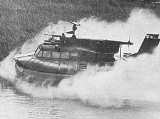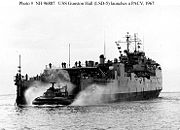
PACV
Encyclopedia

United States Navy
The United States Navy is the naval warfare service branch of the United States Armed Forces and one of the seven uniformed services of the United States. The U.S. Navy is the largest in the world; its battle fleet tonnage is greater than that of the next 13 largest navies combined. The U.S...
river patrol hovercraft
Hovercraft
A hovercraft is a craft capable of traveling over surfaces while supported by a cushion of slow moving, high-pressure air which is ejected against the surface below and contained within a "skirt." Although supported by air, a hovercraft is not considered an aircraft.Hovercraft are used throughout...
used during the Vietnam War
Vietnam War
The Vietnam War was a Cold War-era military conflict that occurred in Vietnam, Laos, and Cambodia from 1 November 1955 to the fall of Saigon on 30 April 1975. This war followed the First Indochina War and was fought between North Vietnam, supported by its communist allies, and the government of...
.
The PACV was based on Bell Aerosystems Bell SK-5 hovercraft; a licensed version of the British Saunders-Roe
Saunders-Roe
Saunders-Roe Limited was a British aero- and marine-engineering company based at Columbine Works East Cowes, Isle of Wight.-History:The name was adopted in 1929 after Alliot Verdon Roe and John Lord took a controlling interest in the boat-builders S.E. Saunders...
(later, British Hovercraft Corporation
British Hovercraft Corporation
British Hovercraft Corporation was the corporate entity created when the Saunders Roe division of Westland Aircraft and Vickers Supermarine combined March 1966 with the intention of creating viable commercial hovercraft - .None of the Vickers designs were 'taken forward', the...
) SR.N5
SR.N5
The Saunders-Roe SR.N5 was a medium-sized hovercraft which first flew in 1964. It was the first production-built hovercraft in the world. A later "stretched" variant of the SR.N5 was produced in greater numbers as the SR.N6....
hovercraft. The SK-5 was adapted for American military use in 1965. Three were purchased by the U.S. Navy for operations in the emerging Vietnam War
Vietnam War
The Vietnam War was a Cold War-era military conflict that occurred in Vietnam, Laos, and Cambodia from 1 November 1955 to the fall of Saigon on 30 April 1975. This war followed the First Indochina War and was fought between North Vietnam, supported by its communist allies, and the government of...
. Training of PACV crews was performed in the waters off Coronado, California
Coronado, California
Coronado, also known as Coronado Island, is an affluent resort city located in San Diego County, California, 5.2 miles from downtown San Diego. Its population was 24,697 at the 2010 census, up from 24,100 at the 2000 census. U.S. News and World Report lists Coronado as one of the most expensive...
near San Diego. Feedback from the training period allowed refinements to the design to be made.
Service
PACVs were first deployed in 1966 to VietnamVietnam
Vietnam – sometimes spelled Viet Nam , officially the Socialist Republic of Vietnam – is the easternmost country on the Indochina Peninsula in Southeast Asia. It is bordered by China to the north, Laos to the northwest, Cambodia to the southwest, and the South China Sea –...
as part of the U.S. Navy's River Patrol Force (Task Force 116). Often called "Pac Vees", they were armed with a .50 caliber machine gun mounted on a rotational platform in the front, side mounted M60 machine gun
M60 machine gun
The M60 is a family of American general-purpose machine guns firing 7.62×51mm NATO cartridges from a disintegrating belt of M13 links...
s, and often remote controlled M60s or grenade launcher
Grenade launcher
A grenade launcher or grenade discharger is a weapon that launches a grenade with more accuracy, higher velocity, and to greater distances than a soldier could throw it by hand....
s in the stern. In addition, the crew, and often U.S. Army Green Berets and ARVN Rangers, riding on the side panels, employed assorted small arms such as M16 rifle
M16 rifle
The M16 is the United States military designation for the AR-15 rifle adapted for both semi-automatic and full-automatic fire. Colt purchased the rights to the AR-15 from ArmaLite, and currently uses that designation only for semi-automatic versions of the rifle. The M16 fires the 5.56×45mm NATO...
s, M79 grenade launcher
M79 grenade launcher
The M79 grenade launcher is a single-shot, shoulder-fired, break-action grenade launcher that fires a 40x46mm grenade which used what the US Army called the High-Low Propulsion System to keep recoil forces low, and first appeared during the Vietnam War...
s, various other rifle
Rifle
A rifle is a firearm designed to be fired from the shoulder, with a barrel that has a helical groove or pattern of grooves cut into the barrel walls. The raised areas of the rifling are called "lands," which make contact with the projectile , imparting spin around an axis corresponding to the...
s, .45 pistols, M60s, and grenade
Grenade
A grenade is a small explosive device that is projected a safe distance away by its user. Soldiers called grenadiers specialize in the use of grenades. The term hand grenade refers any grenade designed to be hand thrown. Grenade Launchers are firearms designed to fire explosive projectile grenades...
s. During PACV's first tour in Vietnam some basic light armor was added to the hovercraft to give it some protection from enemy fire. PACVs conducted many successful missions on the Mekong Delta
Mekong Delta
The Mekong Delta is the region in southwestern Vietnam where the Mekong River approaches and empties into the sea through a network of distributaries. The Mekong delta region encompasses a large portion of southwestern Vietnam of . The size of the area covered by water depends on the season.The...
, Cat Lo, Plain of Reeds out of Moc Hoa
Moc Hoa
Mộc Hóa is a rural district of Long An Province in the Mekong River Delta region of Vietnam.-Divisions:The district is divided into communes:*Mộc Hóa #Bình Phong Thạnh#Tân Thành#Tân Lập#Bình Hòa Đông#Bình Hòa Trung...
in their initial tour.
The Navy withdrew the PACVs for overhaul in December 1966/January 1967 and redeployed them to Vietnam in late 1967. The U.S. Army created its own version of the PACV in 1967 with some of the Navy's modifications from the experimental phase of 1966, calling it the ACV, for air cushion vehicle. There were only three Navy PACVs, and three Army ACVs during the whole Vietnam War
Vietnam War
The Vietnam War was a Cold War-era military conflict that occurred in Vietnam, Laos, and Cambodia from 1 November 1955 to the fall of Saigon on 30 April 1975. This war followed the First Indochina War and was fought between North Vietnam, supported by its communist allies, and the government of...
.
The PACV was too loud for patrol and interdiction missions on the coastline and waterways. However, after "Operation Quai Vat" (Vietnamese for "Monster", which was what the Viet Cong called the PACVs) the PACV showed great prowess and capability in marshy terrain like the Plain of Reeds along the south Vietnamese/Cambodian border.
In Operation Quai Vat in November 1966, the PACV force brought its speed and firepower to bear on the Viet Cong, with many successful attacks and raids, taking prisoners and destroying Viet Cong sanctuaries. Afterwards, the success of operation Quai Vat formed the basis for stationing the Army's ACVs in the Plain of Reeds. It was found that the PACVs could move faster over the slick ground found in southwestern Vietnam, and over the border into Cambodia. Though the loud noise of the PACVs was still an issue, their speed made up for it in this otherwise difficult terrain, especially during the monsoon season. The search and destroy
Search and destroy
Search and Destroy, Seek and Destroy, or even simply S&D, refers to a military strategy that became a notorious component of the Vietnam War. The idea was to insert ground forces into hostile territory, search out the enemy, destroy them, and withdraw immediately afterward...
raids conducted out of Moc Hoa in November 1966 caught the Viet Cong by surprise and resulted in many Viet Cong deaths. With time, and the degree of threat that this new fast and fierce weapon brought with it, the handful of PACVs and ACVs in Vietnam became major targets for the insurgents.
The Green Berets out of Moc Hoa became proponents of the PACV, being involved in many of their early operations.
Survivors
PACV serial number 004 is the only surviving British Hovercraft CorporationBritish Hovercraft Corporation
British Hovercraft Corporation was the corporate entity created when the Saunders Roe division of Westland Aircraft and Vickers Supermarine combined March 1966 with the intention of creating viable commercial hovercraft - .None of the Vickers designs were 'taken forward', the...
-built US Navy PACV, and is currently preserved at the Bellingham International Maritime Museum. The last surviving Army ACV (No. 903) is located at the Army Transportation Museum in Ft. Eustis, VA.

